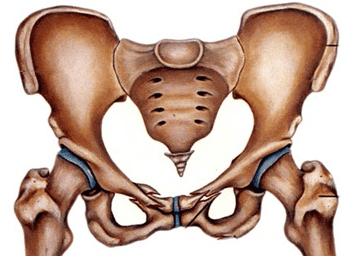This is an automatically translated article.
The article was professionally consulted by Specialist Doctor I Tran Cong Trinh - Radiologist - Radiology Department - Vinmec Central Park International General Hospital. The doctor has many years of experience in the field of diagnostic imaging.A pelvic MRI or pelvic magnetic resonance scan uses a machine with a strong magnetic field and radio waves to create images of structures inside and near the pelvis such as the bladder, prostate, and reproductive organs. ..
1. What is a pelvic MRI?
An MRI scan uses a magnetic field and radio waves to take pictures of the inside of your body without making an incision. The scan allows the doctor to see the soft tissues of the body, such as muscles and organs, that are obstructed by bone.A special pelvic MRI scan helps the doctor see bones, organs, blood vessels, reproductive organs and many other vital organs.
MRI scans help doctors detect potential problems that are suspected in other imaging tests, such as ultrasound. Doctors also use pelvic MRI to diagnose unexplained hip pain, look for metastases in certain cancers, or better understand what's causing your symptoms.
MRI does not use radiation, unlike X-rays and CT scans, so it is considered a safer alternative, especially for pregnant women or young children.

2. Why do I need a pelvic MRI?
Since the pelvic area contains reproductive organs, your doctor may recommend this technique for a variety of reasons depending on your gender.Pelvic MRI is an effective diagnostic technique for both sexes if you have:
Birth defects Injury to the pelvis Abnormal X-ray results Lower abdominal or pelvic pain No resolution determine the cause of difficulty urinating or defecating Cancer (or suspected cancer) in the reproductive organs, bladder, rectum, or urinary tract For women, the doctor may order a pelvic MRI to investigate further you have symptoms such as:
Dry vagina Unusual vaginal bleeding Abnormal lumps or masses in the pelvic area (such as uterine fibroids) Unexplained pain in the lower abdomen or region pelvis For men, a pelvic MRI can look for causes of symptoms such as:
An undescended testicle A lump in the scrotum or testicle, or swelling in the scrotum or testicle area Your doctor will explain Why appoint a pelvic MRI for you so that you can understand and coordinate with your doctor and medical staff to facilitate the scan.

3. What are the risks of a pelvic MRI?
There are a few risks with an MRI because the technique does not use radiation. However, these risks are only present in people whose implants contain human metal. The magnets used in MRI scans can cause problems with pacemakers or cause implant screws or pins to move in the body.That's it, be sure to tell your doctor if you have any implants in your body, for example:
Artificial joints Artificial heart valves Metal plates or screws from orthopedic surgery Pacemakers Heart Metal clip in aneurysm surgery Bullets or other metal fragments A complication that may arise is an allergic reaction to the contrast medium. The most common type of contrast medium is gadolinium. However, the Radiological Society of North America states that these allergic reactions are usually mild and easily controlled with medication. Women are advised not to breast-feed for 24 to 48 hours after the contrast agent is injected.
If you are claustrophobic or uncomfortable in enclosed spaces, you may feel uncomfortable in the MRI machine. Therefore, your doctor may prescribe anti-anxiety medications to reduce discomfort.

4. Procedure for performing pelvic MRI
4.1 Preparing for a pelvic MRI
Before having this technique, tell your doctor if you have a pacemaker or any other metal implanted in your body. Depending on the type of pacemaker you have, your doctor may recommend other diagnostic methods to examine your pelvic area, such as a CT scan. However, some types of pacemakers can be reprogrammed before the MRI scan so that the machine is not interrupted.In addition, because MRI scans use magnets, this machine can attract metal. Tell your doctor if you have any type of metal in your body from surgery or an accident. You will also need to remove all body metal, such as jewelry and bracelets, prior to the shoot. And you'll wear a hospital gown so any metal left on your clothes won't interfere with the scan.
Some types of MRI scans include intravenous contrast injection. This gives a clearer picture of the blood vessels in that area. Contrast is usually gadolinium, which can sometimes cause allergic reactions. Tell your doctor about any allergies you have or if you have had an allergic reaction to contrast in the past.
In some cases, you will need a bowel cleanse before the scan. You may also need to fast for four to six hours before the scan. Women may need to drink plenty of fluids to stretch their bladder, depending on the purpose of the MRI scan.

4.2 Pelvic MRI procedure
The magnetic field generated by the MRI machine creates faint signals, which the machine then records as images. If you must use contrast medium, your nurse or doctor will put it into your bloodstream through an intravenous line. You may need to wait for the contrast medium to circulate in your body before starting the scan.The MRI machine looks like a large metal and plastic donut with a bench that slowly slides you into the center of the machine. You will be safe during the scan if you follow your doctor's instructions and remove all metal. You will lie on your back on the slide to get inside the machine. And you can get a pillow or blanket to make you more comfortable on the bench.
The technician may place small coils of wire around your pelvic area to improve the quality of the scanned images. Or one of the coils may need to go inside the rectum if the doctor needs to focus on examining your prostate or rectum.
The technician will be in another room and remotely control the movement of the bench. But they should be able to communicate with you through the microphone.
The machine may make some loud hissing and loud noises when taking pictures. Many hospitals provide extra earplugs, while others have TVs or headphones to help ease your discomfort.
When the camera takes a picture, the technician will ask you to hold your breath for a few seconds. A typical pelvic MRI lasts about 30 to 60 minutes.

5. What happens after a pelvic MRI?
After a pelvic MRI, you can leave the radiology department/center, unless your doctor tells you otherwise. If you are using sedation, you will have to wait until the medication wears off or someone takes you home after the scan.When the results are available, the doctor will review and explain the results to you. Your doctor may want to order additional tests or diagnostic techniques to gather more information for a final diagnosis. If your doctor has come to a conclusion, they may ask you to start the physical treatment you have.
Vinmec International General Hospital is one of the hospitals that not only ensures professional quality with a team of leading medical doctors, modern equipment and technology, but also stands out for its examination and consultation services. comprehensive and professional medical consultation and treatment; civilized, polite, safe and sterile medical examination and treatment space.
Please dial HOTLINE for more information or register for an appointment HERE. Download MyVinmec app to make appointments faster and to manage your bookings easily.
Article referenced source: healthline.com













